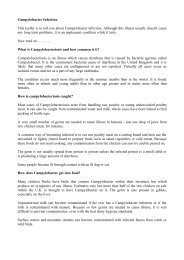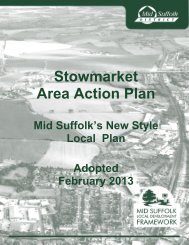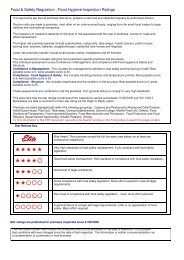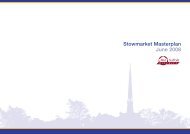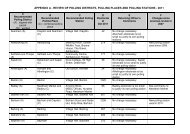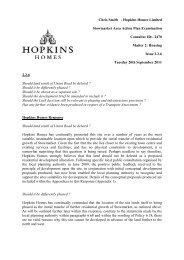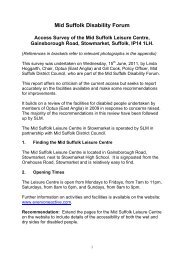Ipswich Housing Market Area Strategic Housing Market Assessment
Ipswich Housing Market Area Strategic Housing Market Assessment
Ipswich Housing Market Area Strategic Housing Market Assessment
You also want an ePaper? Increase the reach of your titles
YUMPU automatically turns print PDFs into web optimized ePapers that Google loves.
Worsening affordability of housing reduces the rate that young adults form households. Oneeffect has been for more young people to live with parents. Nationally, around one in threemen and one in six women aged 20 to 34 now live with their parents, an increase from one infour men and one in seven women in 1997.A lack of choice of housing affects mobility within the labour-market and, therefore, theeconomy. There are also local spatial implications for the <strong>Ipswich</strong> HMA if this trendcontinues such as:– an even greater need for affordable housing in the least affordable areas;– greater household formation in more affordable areas such as <strong>Ipswich</strong>, increasing thebirth-rate which increases demand for schools for example, and– further commuting from more affordable to less affordable areas.Upon the release of detailed results from the 2011 Census, further investigation should beundertaken into the localised effects of affordability on the formation of households. This willassist in understanding the pattern of household change and how affordable homes,including those for low-cost home ownership, can assist the housing choices of youngpeople.National housing policy affects the local supply of affordable homesThe Government has altered the framework for financing new affordable homes and theoperation of state benefits related to housing. The effects of the reforms need to bemonitored, particularly the influence of welfare reform on existing households and thecharacteristics of new households requiring affordable homes.The introduction of the affordable rent model, which are homes let to households who areeligible for social rented housing but at higher rents (up to 80% of the average market value),is another important change. The Communities and Local Government Committee recentlyreported some concern that housing associations will not have the capacity to borrow in thefuture and that local authorities need to be careful to not set a Community Infrastructure Levytoo high, as fewer affordable homes would be delivered.Demographic change with the <strong>Ipswich</strong> HMAThe population of the area has grown steadily since 1981 but growth was not evenlydispersed: Mid Suffolk and Suffolk Coastal had the largest proportionate growth between2001 and 2011. Most of the migratory growth within the HMA is from approximately 2,300people moving from Essex and London each year. Population increase owing to netinternational migration was approximately 740 people annually between 2001 and 2010.The <strong>Ipswich</strong> HMA contains fewer people aged 20 to 40 when compared to the nationalaverage, but comparatively more people at or approaching retirement age and older people.The composition of households has changed with more singles, couples with no children andlone parents; and fewer couples with children.<strong>Ipswich</strong> Study <strong>Area</strong> SHMA Update August 2012 6





